Impact of 3D Printing Technology on Manufacturing Processes
VerifiedAdded on 2020/05/03
|13
|2507
|196
Report
AI Summary
This report provides an executive summary and detailed analysis of 3D printing and addictive manufacturing (AM) technologies. It explores the evolution from traditional manufacturing methods to the use of 3D printing for low-volume production, highlighting its advantages such as cost-effectiveness and environmental friendliness. The report examines various applications of 3D printing across industries like automotive, aerospace, and healthcare, emphasizing valuable situations where it excels. It also forecasts the future of 3D printing, discussing its potential to revolutionize manufacturing processes and reduce production costs. The report concludes by recommending the promotion of 3D printing to industries and summarizing the technology's capacity to produce products efficiently and sustainably.
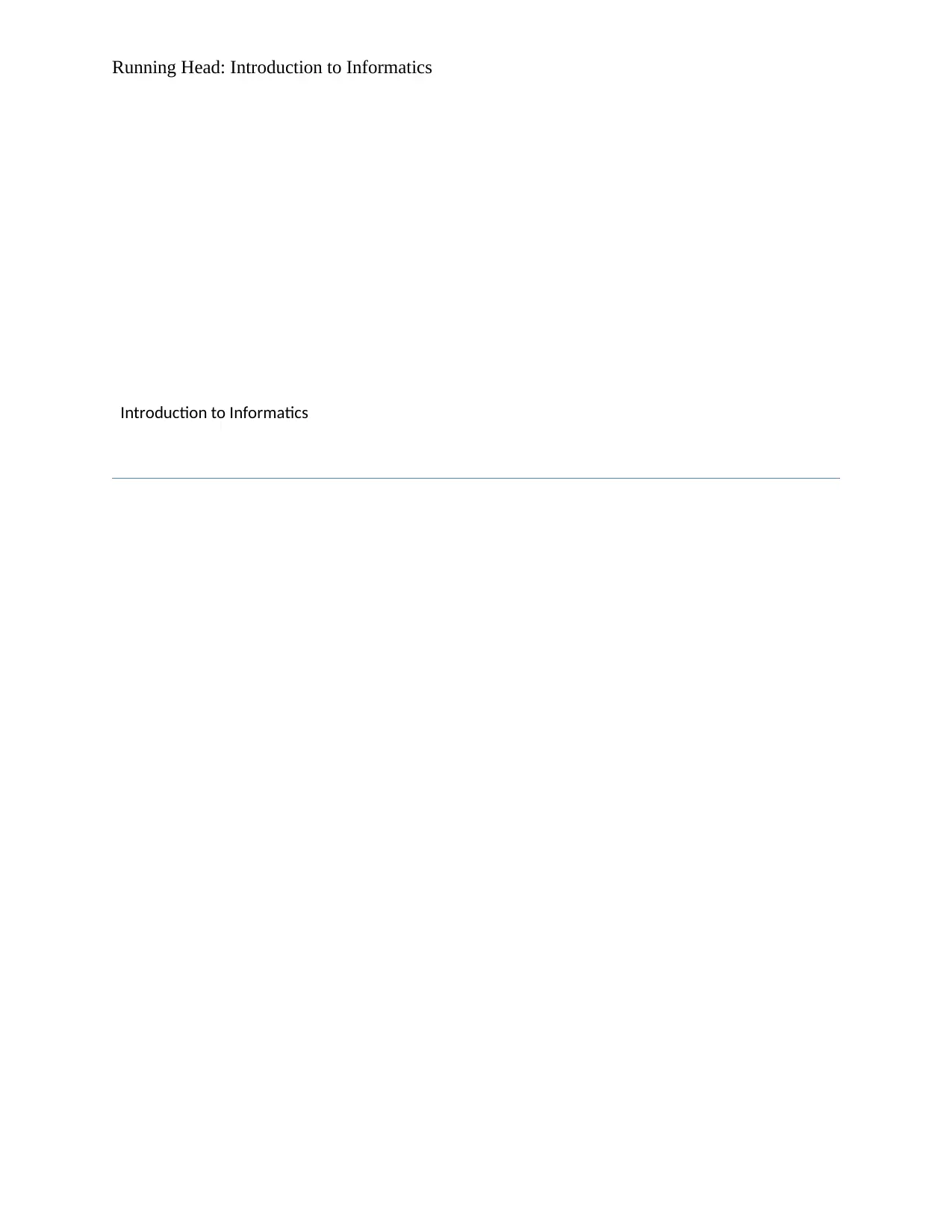
Running Head: Introduction to Informatics
Introduction to Informatics
Introduction to Informatics
Paraphrase This Document
Need a fresh take? Get an instant paraphrase of this document with our AI Paraphraser
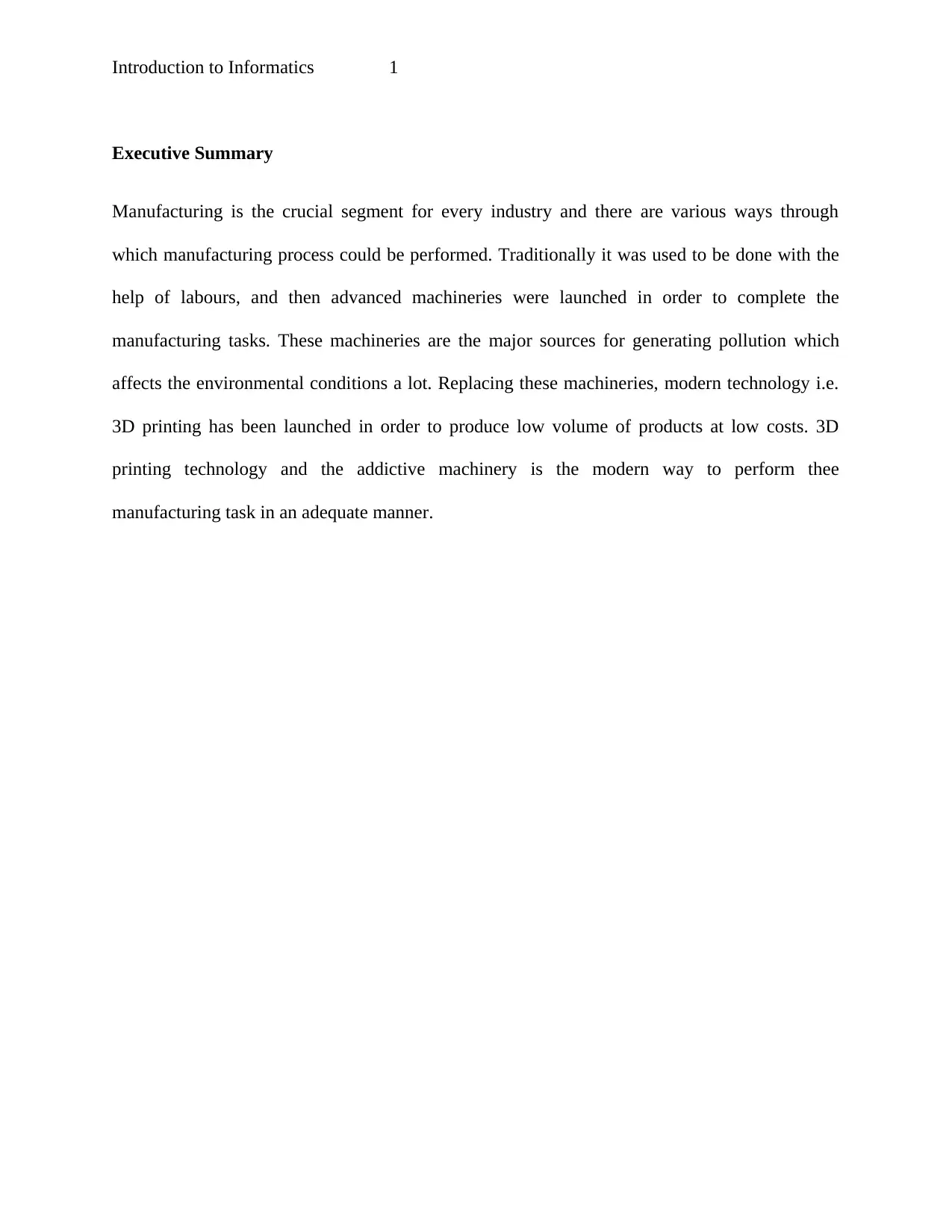
Introduction to Informatics 1
Executive Summary
Manufacturing is the crucial segment for every industry and there are various ways through
which manufacturing process could be performed. Traditionally it was used to be done with the
help of labours, and then advanced machineries were launched in order to complete the
manufacturing tasks. These machineries are the major sources for generating pollution which
affects the environmental conditions a lot. Replacing these machineries, modern technology i.e.
3D printing has been launched in order to produce low volume of products at low costs. 3D
printing technology and the addictive machinery is the modern way to perform thee
manufacturing task in an adequate manner.
Executive Summary
Manufacturing is the crucial segment for every industry and there are various ways through
which manufacturing process could be performed. Traditionally it was used to be done with the
help of labours, and then advanced machineries were launched in order to complete the
manufacturing tasks. These machineries are the major sources for generating pollution which
affects the environmental conditions a lot. Replacing these machineries, modern technology i.e.
3D printing has been launched in order to produce low volume of products at low costs. 3D
printing technology and the addictive machinery is the modern way to perform thee
manufacturing task in an adequate manner.
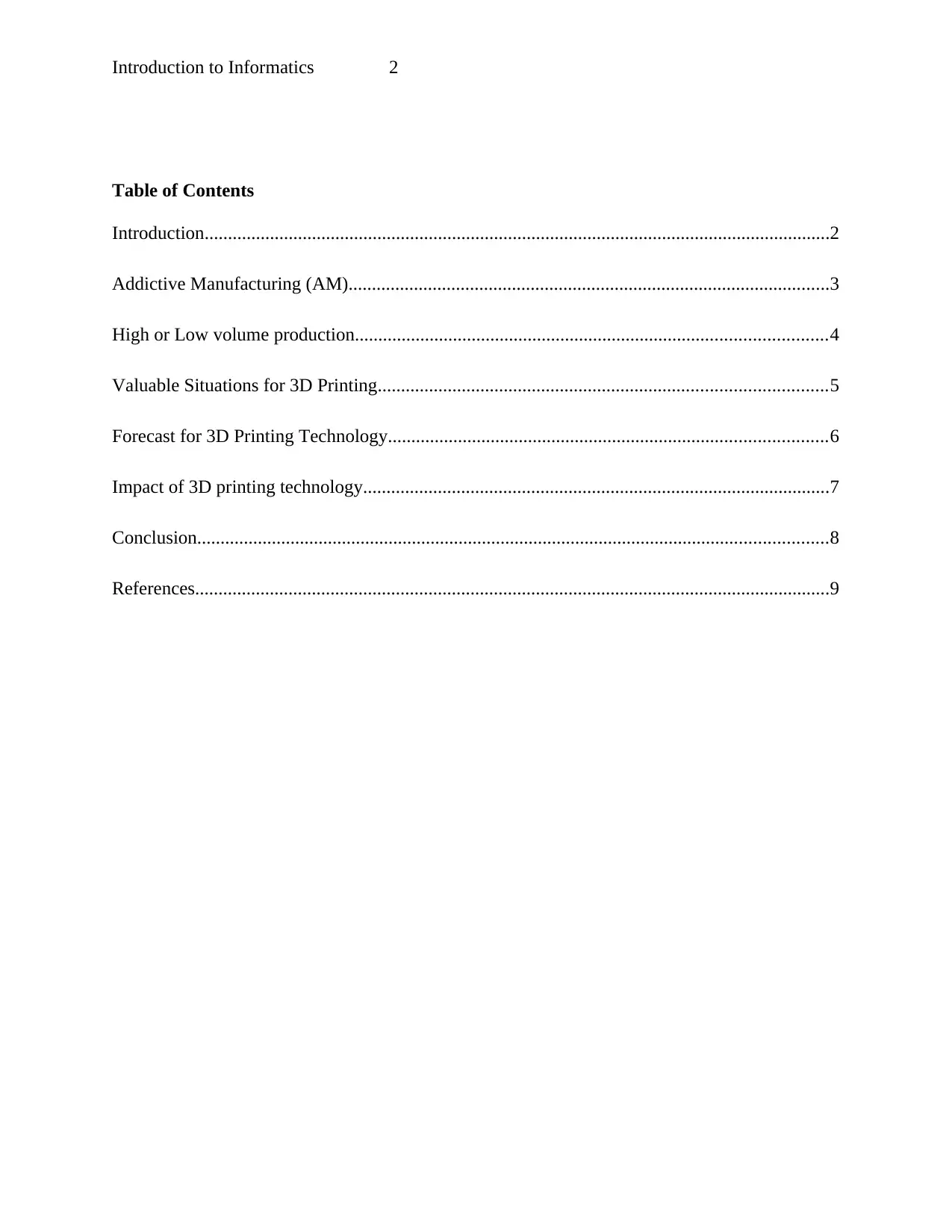
Introduction to Informatics 2
Table of Contents
Introduction......................................................................................................................................2
Addictive Manufacturing (AM).......................................................................................................3
High or Low volume production.....................................................................................................4
Valuable Situations for 3D Printing................................................................................................5
Forecast for 3D Printing Technology..............................................................................................6
Impact of 3D printing technology....................................................................................................7
Conclusion.......................................................................................................................................8
References........................................................................................................................................9
Table of Contents
Introduction......................................................................................................................................2
Addictive Manufacturing (AM).......................................................................................................3
High or Low volume production.....................................................................................................4
Valuable Situations for 3D Printing................................................................................................5
Forecast for 3D Printing Technology..............................................................................................6
Impact of 3D printing technology....................................................................................................7
Conclusion.......................................................................................................................................8
References........................................................................................................................................9
⊘ This is a preview!⊘
Do you want full access?
Subscribe today to unlock all pages.

Trusted by 1+ million students worldwide
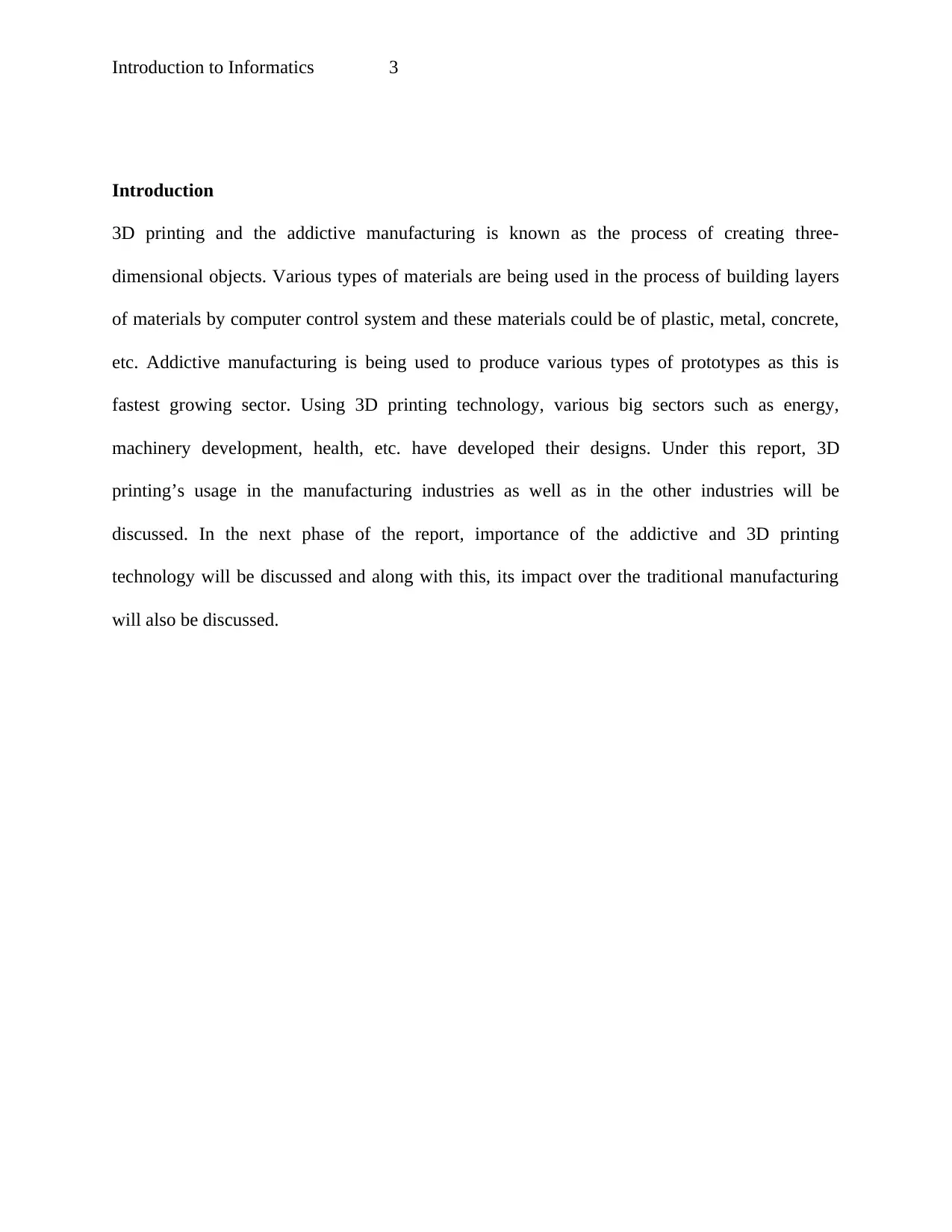
Introduction to Informatics 3
Introduction
3D printing and the addictive manufacturing is known as the process of creating three-
dimensional objects. Various types of materials are being used in the process of building layers
of materials by computer control system and these materials could be of plastic, metal, concrete,
etc. Addictive manufacturing is being used to produce various types of prototypes as this is
fastest growing sector. Using 3D printing technology, various big sectors such as energy,
machinery development, health, etc. have developed their designs. Under this report, 3D
printing’s usage in the manufacturing industries as well as in the other industries will be
discussed. In the next phase of the report, importance of the addictive and 3D printing
technology will be discussed and along with this, its impact over the traditional manufacturing
will also be discussed.
Introduction
3D printing and the addictive manufacturing is known as the process of creating three-
dimensional objects. Various types of materials are being used in the process of building layers
of materials by computer control system and these materials could be of plastic, metal, concrete,
etc. Addictive manufacturing is being used to produce various types of prototypes as this is
fastest growing sector. Using 3D printing technology, various big sectors such as energy,
machinery development, health, etc. have developed their designs. Under this report, 3D
printing’s usage in the manufacturing industries as well as in the other industries will be
discussed. In the next phase of the report, importance of the addictive and 3D printing
technology will be discussed and along with this, its impact over the traditional manufacturing
will also be discussed.
Paraphrase This Document
Need a fresh take? Get an instant paraphrase of this document with our AI Paraphraser
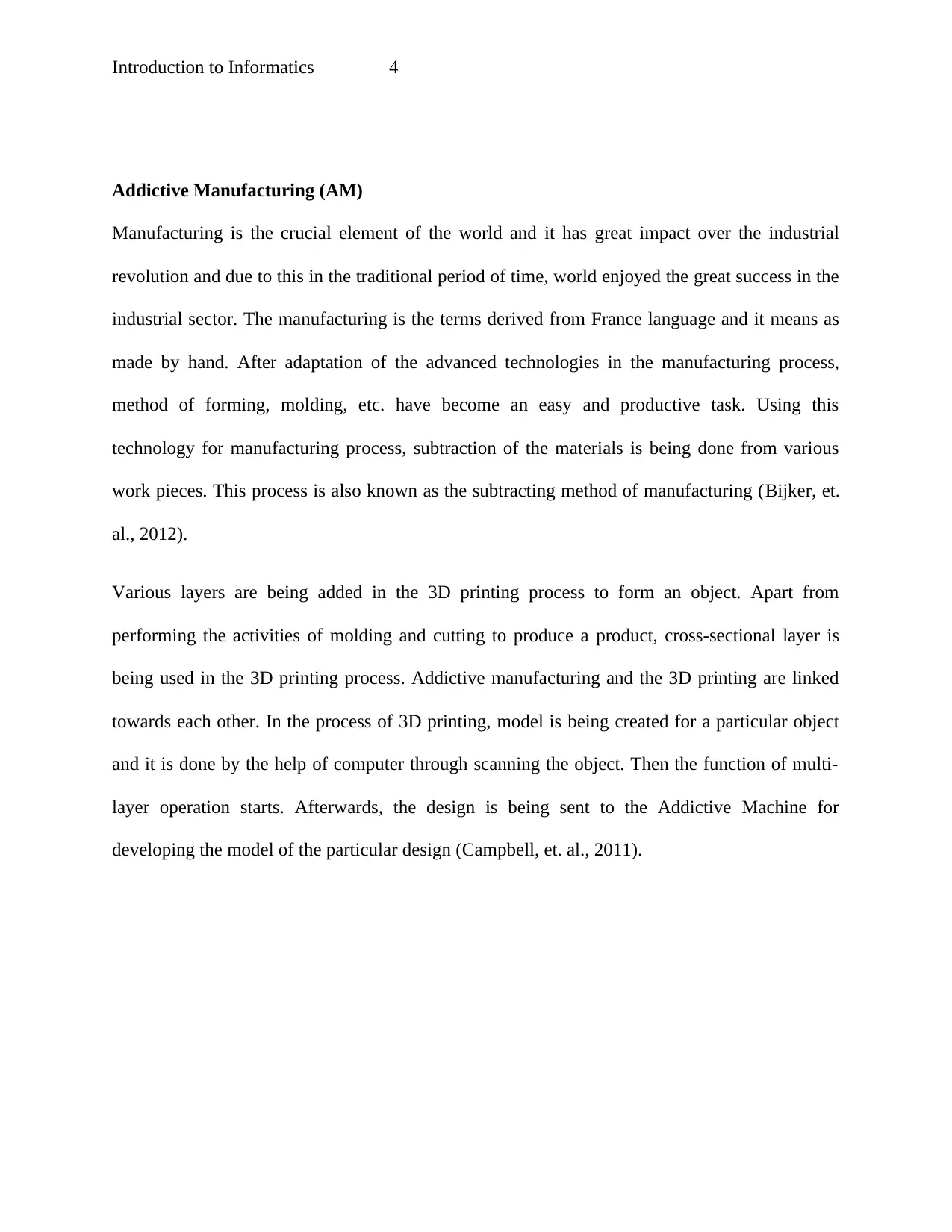
Introduction to Informatics 4
Addictive Manufacturing (AM)
Manufacturing is the crucial element of the world and it has great impact over the industrial
revolution and due to this in the traditional period of time, world enjoyed the great success in the
industrial sector. The manufacturing is the terms derived from France language and it means as
made by hand. After adaptation of the advanced technologies in the manufacturing process,
method of forming, molding, etc. have become an easy and productive task. Using this
technology for manufacturing process, subtraction of the materials is being done from various
work pieces. This process is also known as the subtracting method of manufacturing (Bijker, et.
al., 2012).
Various layers are being added in the 3D printing process to form an object. Apart from
performing the activities of molding and cutting to produce a product, cross-sectional layer is
being used in the 3D printing process. Addictive manufacturing and the 3D printing are linked
towards each other. In the process of 3D printing, model is being created for a particular object
and it is done by the help of computer through scanning the object. Then the function of multi-
layer operation starts. Afterwards, the design is being sent to the Addictive Machine for
developing the model of the particular design (Campbell, et. al., 2011).
Addictive Manufacturing (AM)
Manufacturing is the crucial element of the world and it has great impact over the industrial
revolution and due to this in the traditional period of time, world enjoyed the great success in the
industrial sector. The manufacturing is the terms derived from France language and it means as
made by hand. After adaptation of the advanced technologies in the manufacturing process,
method of forming, molding, etc. have become an easy and productive task. Using this
technology for manufacturing process, subtraction of the materials is being done from various
work pieces. This process is also known as the subtracting method of manufacturing (Bijker, et.
al., 2012).
Various layers are being added in the 3D printing process to form an object. Apart from
performing the activities of molding and cutting to produce a product, cross-sectional layer is
being used in the 3D printing process. Addictive manufacturing and the 3D printing are linked
towards each other. In the process of 3D printing, model is being created for a particular object
and it is done by the help of computer through scanning the object. Then the function of multi-
layer operation starts. Afterwards, the design is being sent to the Addictive Machine for
developing the model of the particular design (Campbell, et. al., 2011).
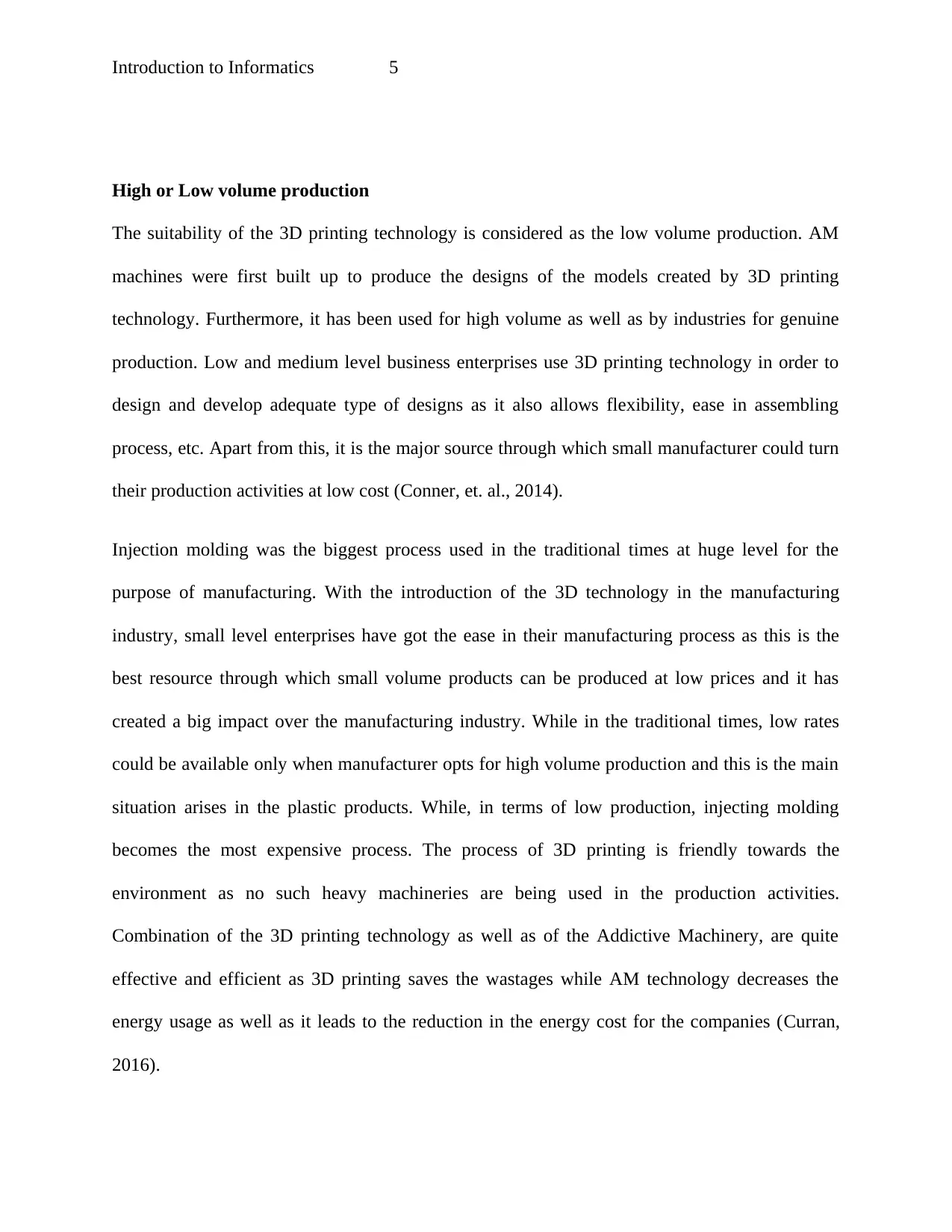
Introduction to Informatics 5
High or Low volume production
The suitability of the 3D printing technology is considered as the low volume production. AM
machines were first built up to produce the designs of the models created by 3D printing
technology. Furthermore, it has been used for high volume as well as by industries for genuine
production. Low and medium level business enterprises use 3D printing technology in order to
design and develop adequate type of designs as it also allows flexibility, ease in assembling
process, etc. Apart from this, it is the major source through which small manufacturer could turn
their production activities at low cost (Conner, et. al., 2014).
Injection molding was the biggest process used in the traditional times at huge level for the
purpose of manufacturing. With the introduction of the 3D technology in the manufacturing
industry, small level enterprises have got the ease in their manufacturing process as this is the
best resource through which small volume products can be produced at low prices and it has
created a big impact over the manufacturing industry. While in the traditional times, low rates
could be available only when manufacturer opts for high volume production and this is the main
situation arises in the plastic products. While, in terms of low production, injecting molding
becomes the most expensive process. The process of 3D printing is friendly towards the
environment as no such heavy machineries are being used in the production activities.
Combination of the 3D printing technology as well as of the Addictive Machinery, are quite
effective and efficient as 3D printing saves the wastages while AM technology decreases the
energy usage as well as it leads to the reduction in the energy cost for the companies (Curran,
2016).
High or Low volume production
The suitability of the 3D printing technology is considered as the low volume production. AM
machines were first built up to produce the designs of the models created by 3D printing
technology. Furthermore, it has been used for high volume as well as by industries for genuine
production. Low and medium level business enterprises use 3D printing technology in order to
design and develop adequate type of designs as it also allows flexibility, ease in assembling
process, etc. Apart from this, it is the major source through which small manufacturer could turn
their production activities at low cost (Conner, et. al., 2014).
Injection molding was the biggest process used in the traditional times at huge level for the
purpose of manufacturing. With the introduction of the 3D technology in the manufacturing
industry, small level enterprises have got the ease in their manufacturing process as this is the
best resource through which small volume products can be produced at low prices and it has
created a big impact over the manufacturing industry. While in the traditional times, low rates
could be available only when manufacturer opts for high volume production and this is the main
situation arises in the plastic products. While, in terms of low production, injecting molding
becomes the most expensive process. The process of 3D printing is friendly towards the
environment as no such heavy machineries are being used in the production activities.
Combination of the 3D printing technology as well as of the Addictive Machinery, are quite
effective and efficient as 3D printing saves the wastages while AM technology decreases the
energy usage as well as it leads to the reduction in the energy cost for the companies (Curran,
2016).
⊘ This is a preview!⊘
Do you want full access?
Subscribe today to unlock all pages.

Trusted by 1+ million students worldwide
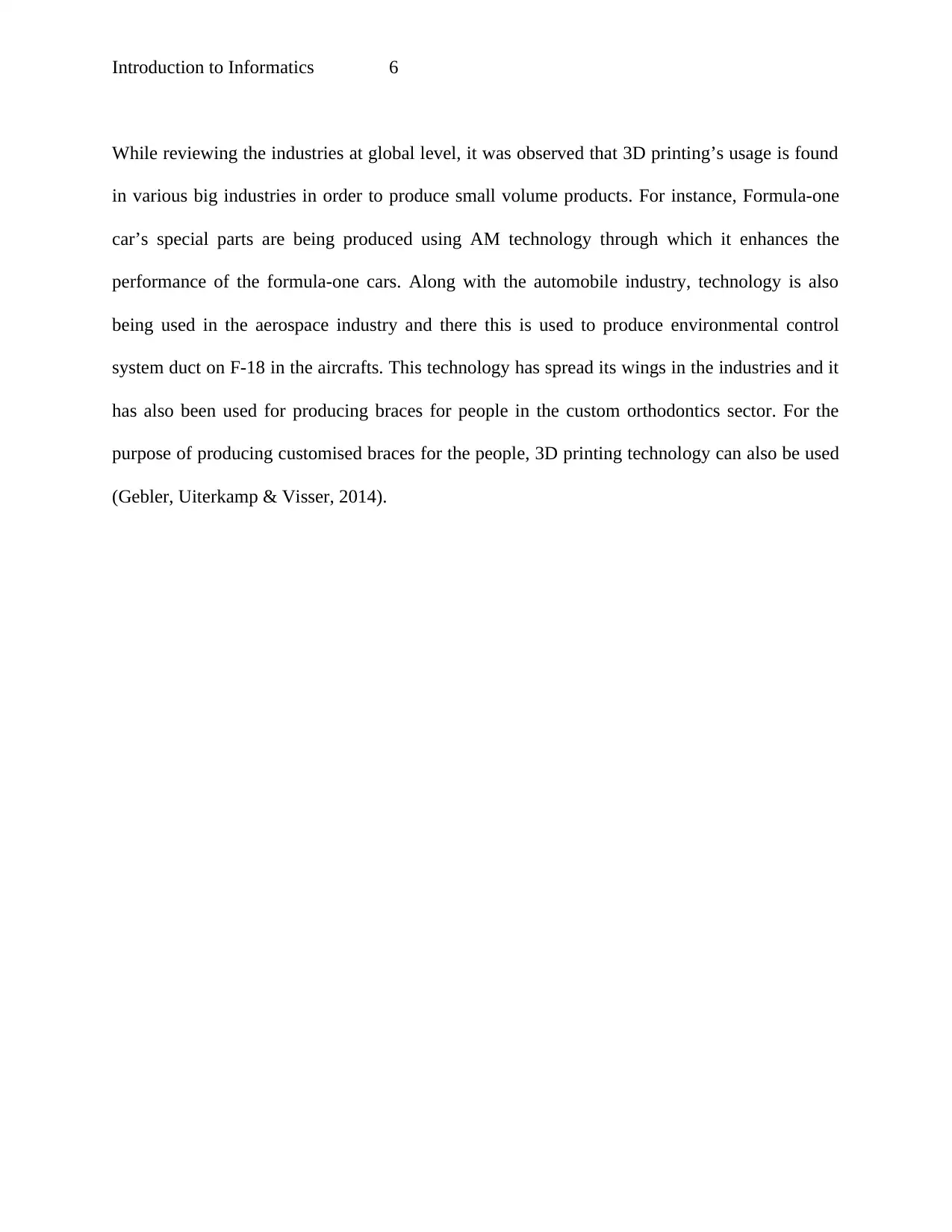
Introduction to Informatics 6
While reviewing the industries at global level, it was observed that 3D printing’s usage is found
in various big industries in order to produce small volume products. For instance, Formula-one
car’s special parts are being produced using AM technology through which it enhances the
performance of the formula-one cars. Along with the automobile industry, technology is also
being used in the aerospace industry and there this is used to produce environmental control
system duct on F-18 in the aircrafts. This technology has spread its wings in the industries and it
has also been used for producing braces for people in the custom orthodontics sector. For the
purpose of producing customised braces for the people, 3D printing technology can also be used
(Gebler, Uiterkamp & Visser, 2014).
While reviewing the industries at global level, it was observed that 3D printing’s usage is found
in various big industries in order to produce small volume products. For instance, Formula-one
car’s special parts are being produced using AM technology through which it enhances the
performance of the formula-one cars. Along with the automobile industry, technology is also
being used in the aerospace industry and there this is used to produce environmental control
system duct on F-18 in the aircrafts. This technology has spread its wings in the industries and it
has also been used for producing braces for people in the custom orthodontics sector. For the
purpose of producing customised braces for the people, 3D printing technology can also be used
(Gebler, Uiterkamp & Visser, 2014).
Paraphrase This Document
Need a fresh take? Get an instant paraphrase of this document with our AI Paraphraser
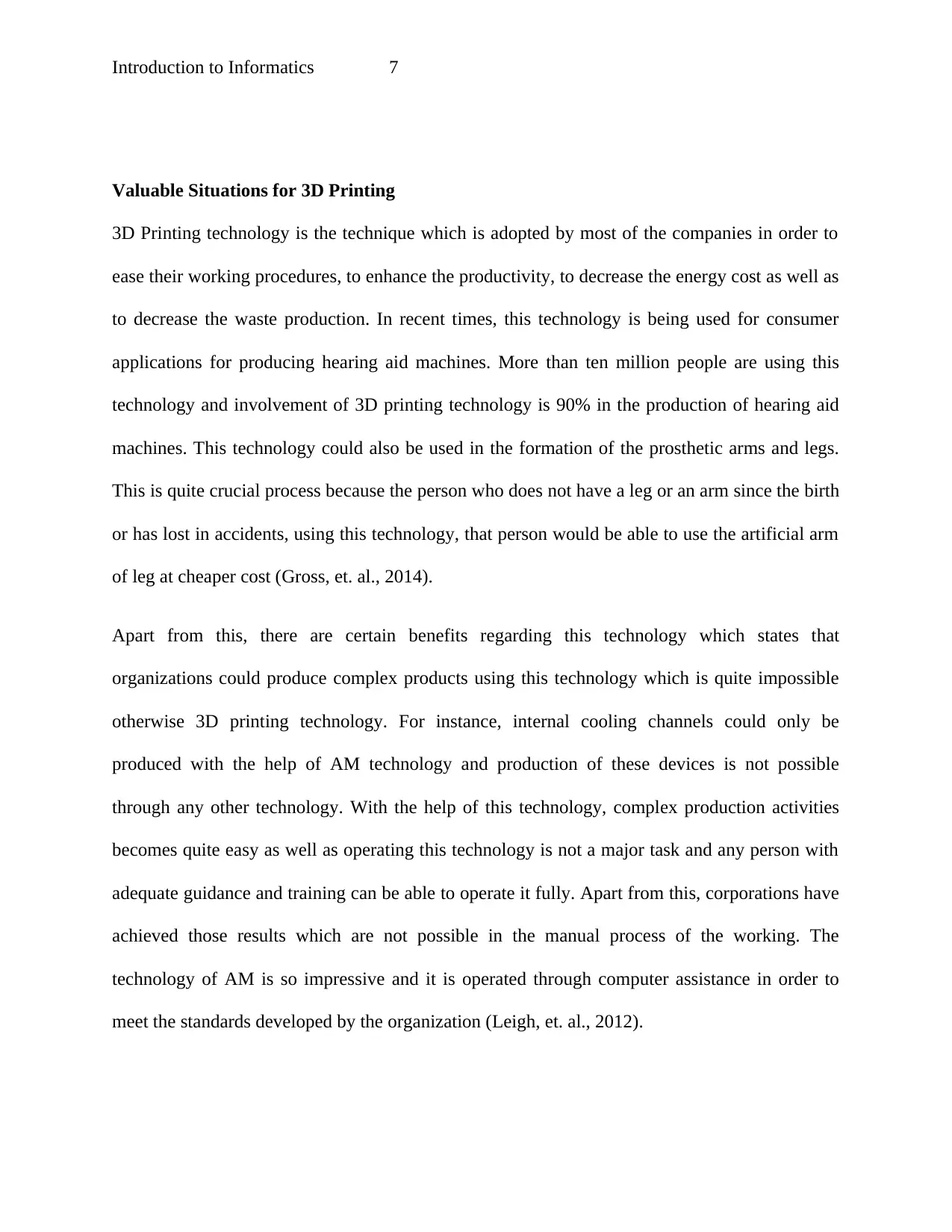
Introduction to Informatics 7
Valuable Situations for 3D Printing
3D Printing technology is the technique which is adopted by most of the companies in order to
ease their working procedures, to enhance the productivity, to decrease the energy cost as well as
to decrease the waste production. In recent times, this technology is being used for consumer
applications for producing hearing aid machines. More than ten million people are using this
technology and involvement of 3D printing technology is 90% in the production of hearing aid
machines. This technology could also be used in the formation of the prosthetic arms and legs.
This is quite crucial process because the person who does not have a leg or an arm since the birth
or has lost in accidents, using this technology, that person would be able to use the artificial arm
of leg at cheaper cost (Gross, et. al., 2014).
Apart from this, there are certain benefits regarding this technology which states that
organizations could produce complex products using this technology which is quite impossible
otherwise 3D printing technology. For instance, internal cooling channels could only be
produced with the help of AM technology and production of these devices is not possible
through any other technology. With the help of this technology, complex production activities
becomes quite easy as well as operating this technology is not a major task and any person with
adequate guidance and training can be able to operate it fully. Apart from this, corporations have
achieved those results which are not possible in the manual process of the working. The
technology of AM is so impressive and it is operated through computer assistance in order to
meet the standards developed by the organization (Leigh, et. al., 2012).
Valuable Situations for 3D Printing
3D Printing technology is the technique which is adopted by most of the companies in order to
ease their working procedures, to enhance the productivity, to decrease the energy cost as well as
to decrease the waste production. In recent times, this technology is being used for consumer
applications for producing hearing aid machines. More than ten million people are using this
technology and involvement of 3D printing technology is 90% in the production of hearing aid
machines. This technology could also be used in the formation of the prosthetic arms and legs.
This is quite crucial process because the person who does not have a leg or an arm since the birth
or has lost in accidents, using this technology, that person would be able to use the artificial arm
of leg at cheaper cost (Gross, et. al., 2014).
Apart from this, there are certain benefits regarding this technology which states that
organizations could produce complex products using this technology which is quite impossible
otherwise 3D printing technology. For instance, internal cooling channels could only be
produced with the help of AM technology and production of these devices is not possible
through any other technology. With the help of this technology, complex production activities
becomes quite easy as well as operating this technology is not a major task and any person with
adequate guidance and training can be able to operate it fully. Apart from this, corporations have
achieved those results which are not possible in the manual process of the working. The
technology of AM is so impressive and it is operated through computer assistance in order to
meet the standards developed by the organization (Leigh, et. al., 2012).
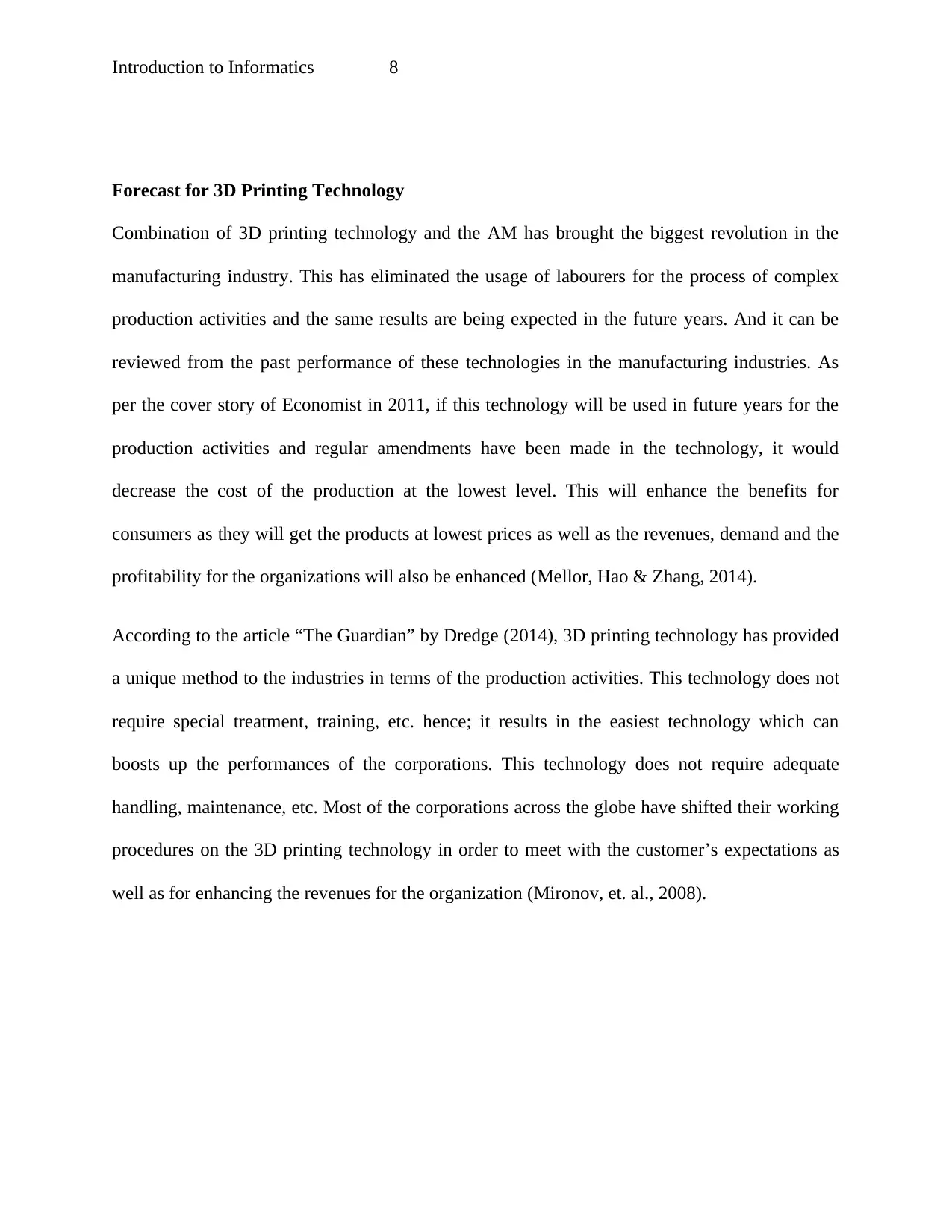
Introduction to Informatics 8
Forecast for 3D Printing Technology
Combination of 3D printing technology and the AM has brought the biggest revolution in the
manufacturing industry. This has eliminated the usage of labourers for the process of complex
production activities and the same results are being expected in the future years. And it can be
reviewed from the past performance of these technologies in the manufacturing industries. As
per the cover story of Economist in 2011, if this technology will be used in future years for the
production activities and regular amendments have been made in the technology, it would
decrease the cost of the production at the lowest level. This will enhance the benefits for
consumers as they will get the products at lowest prices as well as the revenues, demand and the
profitability for the organizations will also be enhanced (Mellor, Hao & Zhang, 2014).
According to the article “The Guardian” by Dredge (2014), 3D printing technology has provided
a unique method to the industries in terms of the production activities. This technology does not
require special treatment, training, etc. hence; it results in the easiest technology which can
boosts up the performances of the corporations. This technology does not require adequate
handling, maintenance, etc. Most of the corporations across the globe have shifted their working
procedures on the 3D printing technology in order to meet with the customer’s expectations as
well as for enhancing the revenues for the organization (Mironov, et. al., 2008).
Forecast for 3D Printing Technology
Combination of 3D printing technology and the AM has brought the biggest revolution in the
manufacturing industry. This has eliminated the usage of labourers for the process of complex
production activities and the same results are being expected in the future years. And it can be
reviewed from the past performance of these technologies in the manufacturing industries. As
per the cover story of Economist in 2011, if this technology will be used in future years for the
production activities and regular amendments have been made in the technology, it would
decrease the cost of the production at the lowest level. This will enhance the benefits for
consumers as they will get the products at lowest prices as well as the revenues, demand and the
profitability for the organizations will also be enhanced (Mellor, Hao & Zhang, 2014).
According to the article “The Guardian” by Dredge (2014), 3D printing technology has provided
a unique method to the industries in terms of the production activities. This technology does not
require special treatment, training, etc. hence; it results in the easiest technology which can
boosts up the performances of the corporations. This technology does not require adequate
handling, maintenance, etc. Most of the corporations across the globe have shifted their working
procedures on the 3D printing technology in order to meet with the customer’s expectations as
well as for enhancing the revenues for the organization (Mironov, et. al., 2008).
⊘ This is a preview!⊘
Do you want full access?
Subscribe today to unlock all pages.

Trusted by 1+ million students worldwide
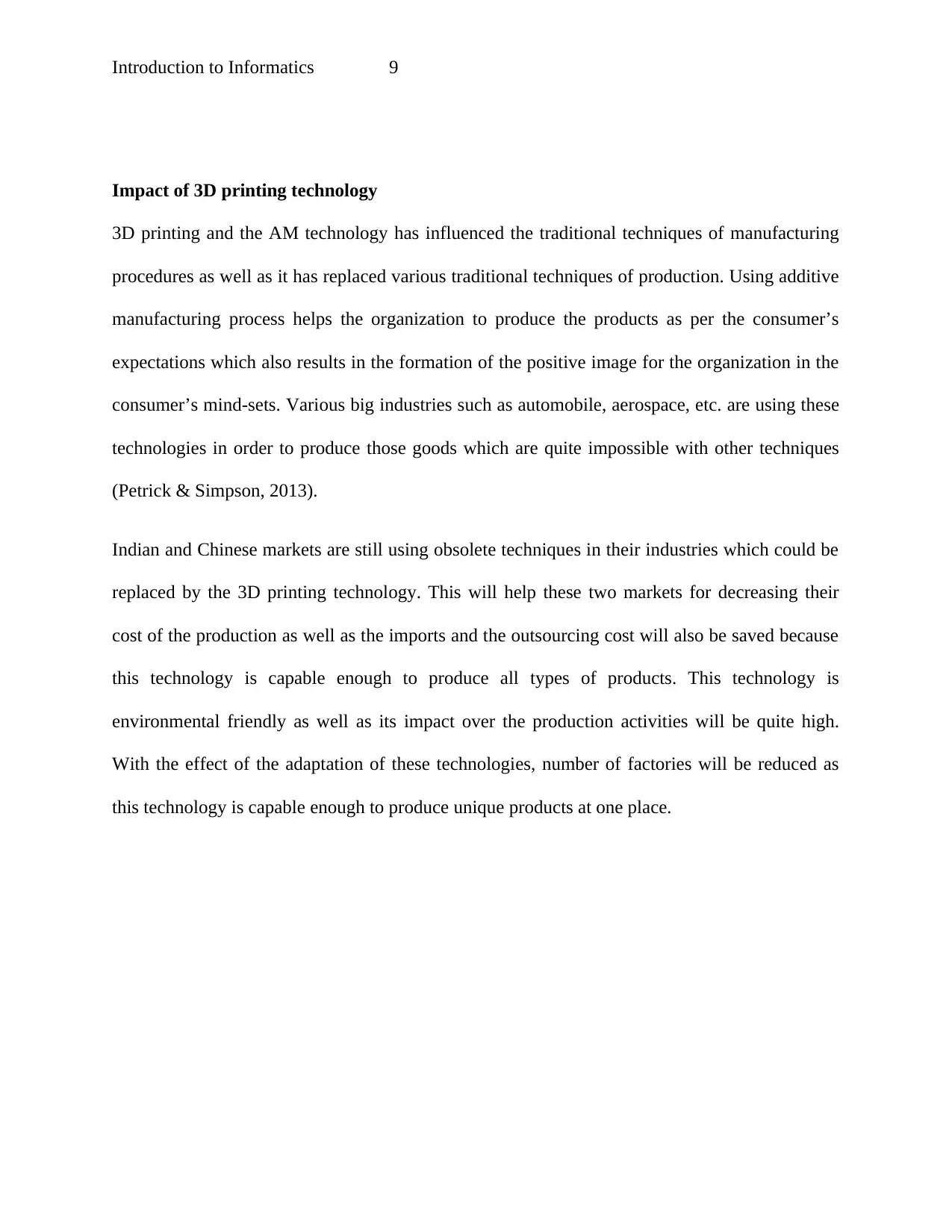
Introduction to Informatics 9
Impact of 3D printing technology
3D printing and the AM technology has influenced the traditional techniques of manufacturing
procedures as well as it has replaced various traditional techniques of production. Using additive
manufacturing process helps the organization to produce the products as per the consumer’s
expectations which also results in the formation of the positive image for the organization in the
consumer’s mind-sets. Various big industries such as automobile, aerospace, etc. are using these
technologies in order to produce those goods which are quite impossible with other techniques
(Petrick & Simpson, 2013).
Indian and Chinese markets are still using obsolete techniques in their industries which could be
replaced by the 3D printing technology. This will help these two markets for decreasing their
cost of the production as well as the imports and the outsourcing cost will also be saved because
this technology is capable enough to produce all types of products. This technology is
environmental friendly as well as its impact over the production activities will be quite high.
With the effect of the adaptation of these technologies, number of factories will be reduced as
this technology is capable enough to produce unique products at one place.
Impact of 3D printing technology
3D printing and the AM technology has influenced the traditional techniques of manufacturing
procedures as well as it has replaced various traditional techniques of production. Using additive
manufacturing process helps the organization to produce the products as per the consumer’s
expectations which also results in the formation of the positive image for the organization in the
consumer’s mind-sets. Various big industries such as automobile, aerospace, etc. are using these
technologies in order to produce those goods which are quite impossible with other techniques
(Petrick & Simpson, 2013).
Indian and Chinese markets are still using obsolete techniques in their industries which could be
replaced by the 3D printing technology. This will help these two markets for decreasing their
cost of the production as well as the imports and the outsourcing cost will also be saved because
this technology is capable enough to produce all types of products. This technology is
environmental friendly as well as its impact over the production activities will be quite high.
With the effect of the adaptation of these technologies, number of factories will be reduced as
this technology is capable enough to produce unique products at one place.
Paraphrase This Document
Need a fresh take? Get an instant paraphrase of this document with our AI Paraphraser
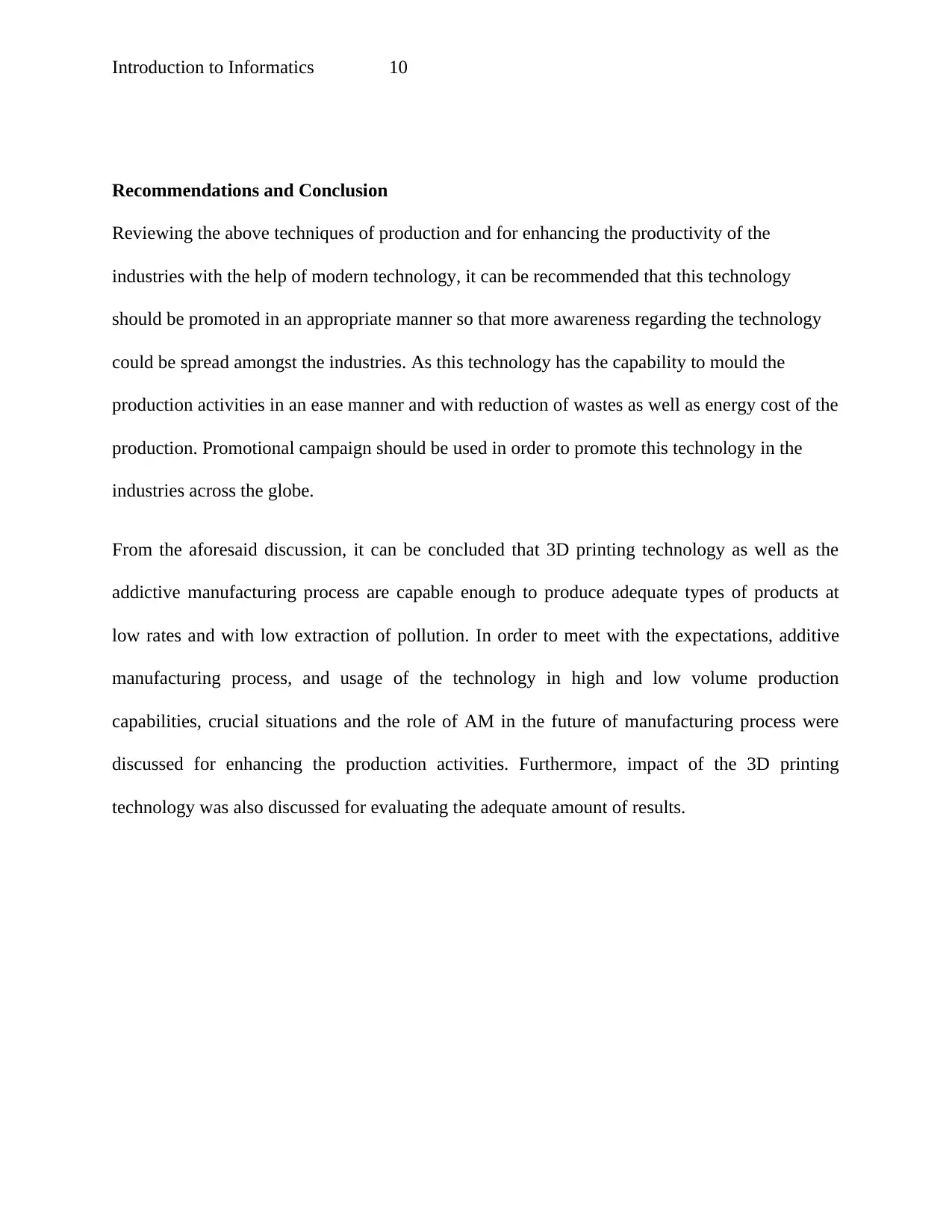
Introduction to Informatics 10
Recommendations and Conclusion
Reviewing the above techniques of production and for enhancing the productivity of the
industries with the help of modern technology, it can be recommended that this technology
should be promoted in an appropriate manner so that more awareness regarding the technology
could be spread amongst the industries. As this technology has the capability to mould the
production activities in an ease manner and with reduction of wastes as well as energy cost of the
production. Promotional campaign should be used in order to promote this technology in the
industries across the globe.
From the aforesaid discussion, it can be concluded that 3D printing technology as well as the
addictive manufacturing process are capable enough to produce adequate types of products at
low rates and with low extraction of pollution. In order to meet with the expectations, additive
manufacturing process, and usage of the technology in high and low volume production
capabilities, crucial situations and the role of AM in the future of manufacturing process were
discussed for enhancing the production activities. Furthermore, impact of the 3D printing
technology was also discussed for evaluating the adequate amount of results.
Recommendations and Conclusion
Reviewing the above techniques of production and for enhancing the productivity of the
industries with the help of modern technology, it can be recommended that this technology
should be promoted in an appropriate manner so that more awareness regarding the technology
could be spread amongst the industries. As this technology has the capability to mould the
production activities in an ease manner and with reduction of wastes as well as energy cost of the
production. Promotional campaign should be used in order to promote this technology in the
industries across the globe.
From the aforesaid discussion, it can be concluded that 3D printing technology as well as the
addictive manufacturing process are capable enough to produce adequate types of products at
low rates and with low extraction of pollution. In order to meet with the expectations, additive
manufacturing process, and usage of the technology in high and low volume production
capabilities, crucial situations and the role of AM in the future of manufacturing process were
discussed for enhancing the production activities. Furthermore, impact of the 3D printing
technology was also discussed for evaluating the adequate amount of results.
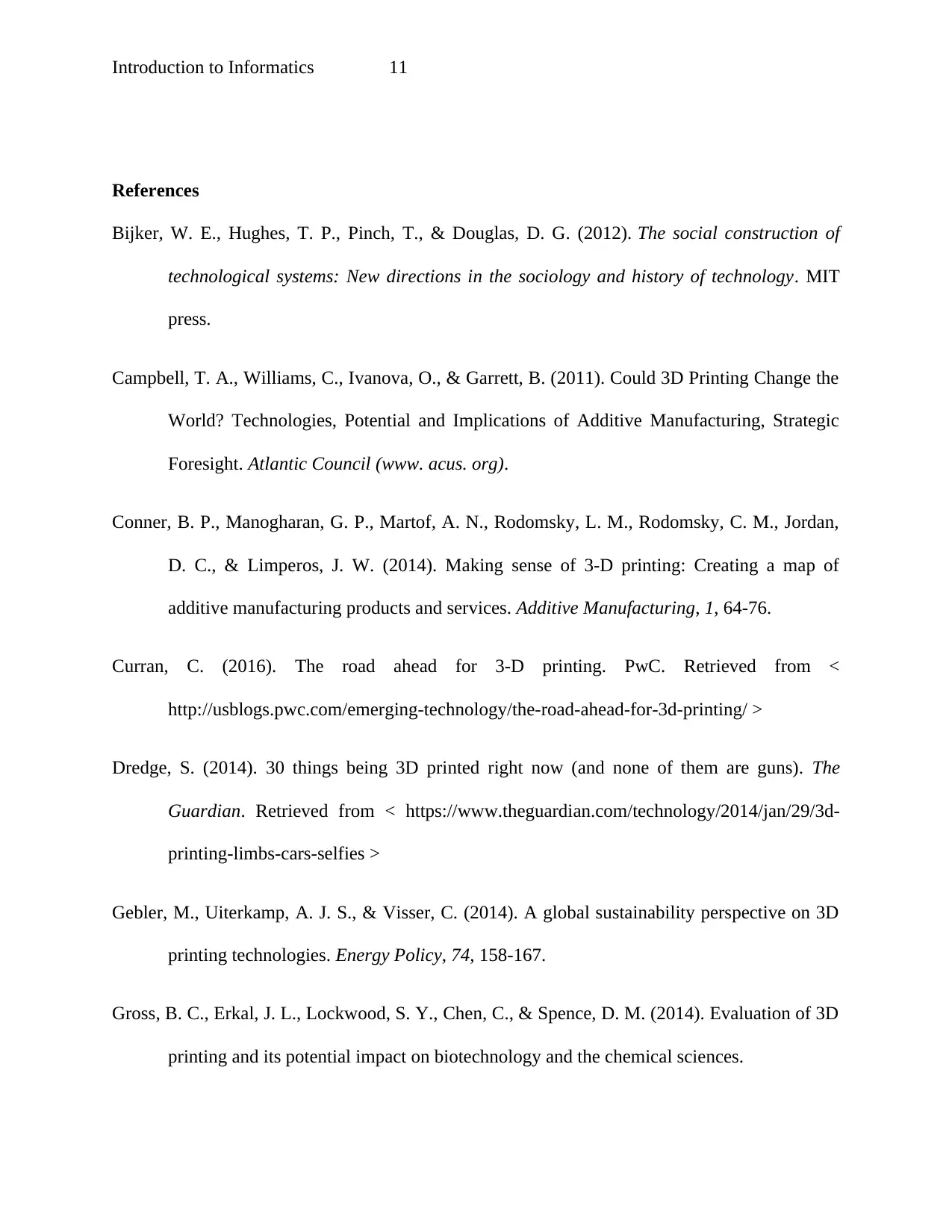
Introduction to Informatics 11
References
Bijker, W. E., Hughes, T. P., Pinch, T., & Douglas, D. G. (2012). The social construction of
technological systems: New directions in the sociology and history of technology. MIT
press.
Campbell, T. A., Williams, C., Ivanova, O., & Garrett, B. (2011). Could 3D Printing Change the
World? Technologies, Potential and Implications of Additive Manufacturing, Strategic
Foresight. Atlantic Council (www. acus. org).
Conner, B. P., Manogharan, G. P., Martof, A. N., Rodomsky, L. M., Rodomsky, C. M., Jordan,
D. C., & Limperos, J. W. (2014). Making sense of 3-D printing: Creating a map of
additive manufacturing products and services. Additive Manufacturing, 1, 64-76.
Curran, C. (2016). The road ahead for 3-D printing. PwC. Retrieved from <
http://usblogs.pwc.com/emerging-technology/the-road-ahead-for-3d-printing/ >
Dredge, S. (2014). 30 things being 3D printed right now (and none of them are guns). The
Guardian. Retrieved from < https://www.theguardian.com/technology/2014/jan/29/3d-
printing-limbs-cars-selfies >
Gebler, M., Uiterkamp, A. J. S., & Visser, C. (2014). A global sustainability perspective on 3D
printing technologies. Energy Policy, 74, 158-167.
Gross, B. C., Erkal, J. L., Lockwood, S. Y., Chen, C., & Spence, D. M. (2014). Evaluation of 3D
printing and its potential impact on biotechnology and the chemical sciences.
References
Bijker, W. E., Hughes, T. P., Pinch, T., & Douglas, D. G. (2012). The social construction of
technological systems: New directions in the sociology and history of technology. MIT
press.
Campbell, T. A., Williams, C., Ivanova, O., & Garrett, B. (2011). Could 3D Printing Change the
World? Technologies, Potential and Implications of Additive Manufacturing, Strategic
Foresight. Atlantic Council (www. acus. org).
Conner, B. P., Manogharan, G. P., Martof, A. N., Rodomsky, L. M., Rodomsky, C. M., Jordan,
D. C., & Limperos, J. W. (2014). Making sense of 3-D printing: Creating a map of
additive manufacturing products and services. Additive Manufacturing, 1, 64-76.
Curran, C. (2016). The road ahead for 3-D printing. PwC. Retrieved from <
http://usblogs.pwc.com/emerging-technology/the-road-ahead-for-3d-printing/ >
Dredge, S. (2014). 30 things being 3D printed right now (and none of them are guns). The
Guardian. Retrieved from < https://www.theguardian.com/technology/2014/jan/29/3d-
printing-limbs-cars-selfies >
Gebler, M., Uiterkamp, A. J. S., & Visser, C. (2014). A global sustainability perspective on 3D
printing technologies. Energy Policy, 74, 158-167.
Gross, B. C., Erkal, J. L., Lockwood, S. Y., Chen, C., & Spence, D. M. (2014). Evaluation of 3D
printing and its potential impact on biotechnology and the chemical sciences.
⊘ This is a preview!⊘
Do you want full access?
Subscribe today to unlock all pages.

Trusted by 1+ million students worldwide
1 out of 13
Related Documents
Your All-in-One AI-Powered Toolkit for Academic Success.
+13062052269
info@desklib.com
Available 24*7 on WhatsApp / Email
![[object Object]](/_next/static/media/star-bottom.7253800d.svg)
Unlock your academic potential
Copyright © 2020–2025 A2Z Services. All Rights Reserved. Developed and managed by ZUCOL.





